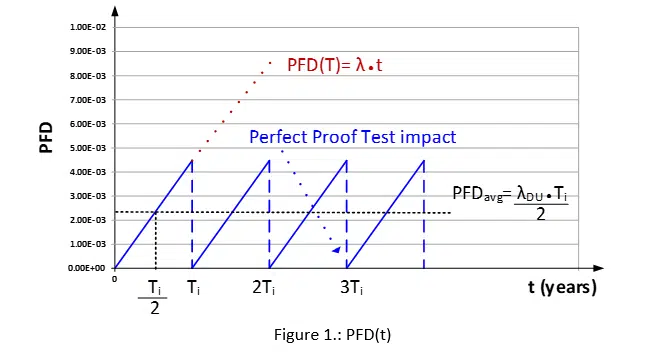Ultima modifica: 09/01/2024
L’Average PFD è definito come

Ti è il momento in cui il sistema viene sottoposto a test di funzionamento. Il PFD(T) di un SIF, che viene testato periodicamente, è rappresentato da una curva a dente di sega, con una probabilità che va da un minimo, subito dopo il test, a un massimo, subito prima del test successivo.
Il suo valore medio, o PFDavg, è rappresentato nella Figura 1 .

I Guasti Pericolosi
When dealing with Safety Critical Systems, the important failures are the dangerous ones. Those can be divided into Dangerous Detectable by the Diagnostic tests and Dangerous Undetectable.
Dangerous Undetected Failures (DU) prevent the activation, on demand, of the safety system and are also called dormant failures.
Dangerous Detected Failures (DD) are may be found immediately when they occur, for example, by an automatic built in self-test. A short circuit on a normally closed free voltage contact can be revealed with the so called “trigger” function, now available in almost all Safety-related Control Systems (chapter 3).
In low demand mode, Dangerous Detected failures do not play a role in the Unreliability of a Safety System, since, often, they are detected as soon as they appear and the process is immediately shut down. Therefore, the only significant failures that influence the value of the PFDavg, are the DU failures. Therefore, Equation can be written as:
Quando si tratta di Safety Critical Systems, i guasti importanti sono quelli pericolosi. Questi possono essere suddivisi in pericolosi rilevabili dai test diagnostici e pericolosi non rilevabili.
I Dangerous Undetected Failures (DU) impediscono l’attivazione, su richiesta, del sistema di sicurezza e sono anche chiamati guasti inattivi.
I Dangerous Detected Failures (DD) possono essere individuati immediatamente quando si verificano, ad esempio tramite un autotest automatico incorporato. Un cortocircuito su un contatto normalmente chiuso a tensione libera può essere rilevato con la cosiddetta funzione “trigger”, ora disponibile in quasi tutti i sistemi di controllo di sicurezza (capitolo 3).
In low demand, Dangerous Detected Failures non giocano un ruolo nell’inaffidabilità di un sistema di sicurezza, poiché spesso vengono rilevati non appena compaiono e il processo viene immediatamente arrestato. Pertanto, gli unici guasti significativi che influenzano il valore del PFDavg sono i guasti DU. Pertanto, l’equazione può essere scritta come:

The test interval Ti is decided based upon the demand rate, so that there is a fair chance that a Dangerous Undetected fault is revealed and corrected before a demand occurs, such that a hazardous event is avoided.